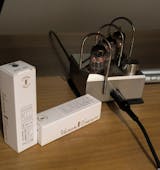
6550 Tung-Sol NOS vs KT88 Genalex NOS: High-end audio tube duel – Part I
Share
The Obsession with Power: A Cultural Phenomenon
In the world of high fidelity and amplified music, few NOS audio tubes have captured the collective imagination like the 6550 and the KT88. Born to respond to the irrepressible desire for sonic power that exploded in the 1950s, these two tubes have established themselves as archetypes of two distinct but complementary schools of sound: the robust and pragmatic efficiency of the American school, embodied by the 6550; the dynamic and refined elegance of the British approach, represented by the Genalex KT88.
Even today, in 2025, they continue to be discussed, divided, and fascinating. Because these are not just tubes: they are symbols of two listening philosophies, two approaches to building amplifiers, two sonic identities. Those who really know them know that choosing between a 6550 NOS and a KT88 NOS is more than a technical option. It is a declaration of intent.
NOS 6550 Tubes: American Power and Control
The Beginnings: In Search of Watts
In the golden age of hi-fi, getting more than 30 watts of real power was an expensive endeavor. It required at least four 6L6Gs at 300-400V plate voltages, or the use of transmitter tubes at even higher voltages. A pair of 807s could do the job, but only with over 550V, oil-filled capacitors in the power supply, and expensive transformers. By the time the buyer had already invested in a tuner, turntable, cabinet, and speakers, there was little left for a transmitter tube power amp.
Power demands were high, despite the widespread use of efficient loudspeakers and horns. The RCA 6146 promised up to 100 watts, but its use was limited to transmitters or theater amplifiers. The only known 6146 music amplifier was the 1964 Ampeg SVT.
What was needed was a powerful, low distortion, and less expensive tube than the 6146. The Mullard EL37 could compete, but it cost the same. The answer came in 1955 with the Tung-Sol 6550.
The arrival of the 6550 Tung-Sol
Tung-Sol designed the 6550 for home audio applications, with a capless structure and an octal base with a metal ring at cathode potential to improve electrical stability. The classic “Coke Bottle” shape gave it a visual identity and compactness.
With a dissipation of 35 watts in tetrode and 40 watts in triode, marketers and manufacturers could boast that two push-pull 6550s would replace four or more lesser tubes. The tube handled 600V on the plate, 400V on the screen grid, and had about twice the transconductance of a 6L6. Gold-plated and carbonized grids, low grid 1 resistance, and thermal reliability made it a success.
6550 Tung-Sol Technical Specifications
- Anode dissipation: up to 42W
- Maximum anode voltage: 660V
- Grid 2: 440V (pentode), 500V (triode/ultralinear)
- Maximum cathode current: 190 mA
- Grid voltage 1: -300V to 0V
- Grid resistance 1 (fixed bias): 50kΩ
- Maximum bulb temperature: 250°C
Three main variants:
- Type 1: Upper getter, closed plate
- Type 2: Upper getter, perforated plate
- Type 3: Top + Side Getter, Perforated Plate
Many were rebadged by Raytheon, RCA, Sylvania.
Numerous hi-fi amplifiers adopted it: McIntosh MC60, Heath WM-6, Fisher 55A, Scott LK-150.
KT88 NOS Genalex: the European answer
In 1957, Marconi-Osram Valve Company (Genalex) launched the KT88 to directly compete with the 6550. The first KT88 had the ST shape like the Tung-Sol, later replaced by the classic straight cylinder. It was immediately adopted in iconic designs: Leak TL50+, Dynaco Mark III, Harman-Kardon Citation II, McIntosh MC75/275, Marshall Major 200W (1967).
The KT88 could handle 650V with ease in triode and ultralinear configurations, where the 6550 began to struggle.
- Genalex KT88 Technical Specifications
- Maximum anode voltage: 800V
- Maximum anode dissipation: 42W (35W recommended)
- Maximum cathode current: 230 mA
- Total dissipation: 46W
Distortion was contained even with strong feedback, making it ideal for high-fidelity class AB1 amplifiers.
In the 1970s and 1980s, both were chosen in top designs from Audio Research, Conrad-Johnson, MFA, Theta, and Jadis. The KT88 was the limit Class A, while GE’s 6550A was used for reliability and thermal management (metal clad plates). Many US-market Marshalls used 6550As for robustness, although this did not match the classic “crunch” sound.
Two sound schools, two design philosophies
The 6550 is linear, solid, controlled in the bass, coherent in the mids and precise in the highs. Reliable, versatile, but less flashy.
The KT88 is more airy, with a wide soundstage and chiseled mids. Dynamic and musical, it requires accurate circuitry to give its best.
Conclusion of Part I
By the late 1960s, both had become mainstays of audio design: in hi-fi systems, recording studios, guitar amplifiers, and PA systems. The 6550 for rigor and tightness, the KT88 for dynamics and involvement.
In 2025, seventy years later, they are still sought after, discussed, loved. The question remains: which one sounds better? It depends on the amplifier. And the listener.
In Part II we will focus on the real-world comparison between the reference NOS models: the original 6550 Tung-Sol and the KT88 Genalex GEC.
FAQ
Which hi-fi amplifiers use the 6550 or KT88?
Notable models include McIntosh MC275, Audio Research, Conrad-Johnson, Dynaco MKIII, Leben CS600X, Icon Audio.
Can 6550s replace KT88s?
Often yes, but the circuit and bias must be checked. Some amps are optimized for only one type.
What does NOS mean?
“New Old Stock”: original vintage valves never used, different from the current reissues.
Where to find tested NOS 6550 and KT88 tubes?
At specialized dealers, with documented tests carried out on Amplitrex.


